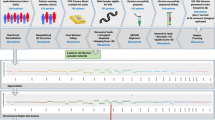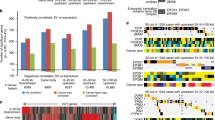Abstract
To identify genomic abnormalities characteristic of pancreatic ductal adenocarcinoma (PDAC) in vivo, a panel of 27 microdissected PDAC specimens were analysed using high-density microarrays representing ∼116 000 single nucleotide polymorphism (SNP) loci. We detected frequent gains of 1q, 2, 3, 5, 7p, 8q, 11, 14q and 17q (⩾78% of cases), and losses of 1p, 3p, 6, 9p, 13q, 14q, 17p and 18q (⩾44%). Although the results were comparable with those from array CGH, regions of those genetic changes were defined more accurately by SNP arrays. Integrating the Ensembl public data, we have generated ‘gene’ copy number indices that facilitate the search for novel candidates involved in pancreatic carcinogenesis. Copy numbers in a subset of the genes were validated using quantitative real-time PCR. The SKAP2/SCAP2 gene (7p15.2), which belongs to the src family kinases, was most frequently (63%) amplified in our sample set and its recurrent overexpression (67%) was confirmed by reverse transcription–PCR. Furthermore, fluorescence in situ hybridization and in situ RNA hybridization analyses for this gene have demonstrated a significant correlation between DNA copy number and mRNA expression level in an independent sample set (P<0.001). These findings indicate that the dysregulation of SKAP2/SCAP2, which is mostly caused by its increased gene copy number, is likely to be associated with the development of PDAC.
This is a preview of subscription content, access via your institution
Access options
Subscribe to this journal
Receive 50 print issues and online access
$259.00 per year
only $5.18 per issue
Buy this article
- Purchase on Springer Link
- Instant access to full article PDF
Prices may be subject to local taxes which are calculated during checkout




Similar content being viewed by others
Abbreviations
- array CGH:
-
array-based comparative genomic hybridization
- DCN:
-
DNA copy number
- FISH:
-
fluorescence in situ hybridization
- ISH:
-
in situ RNA hybridization
- LOH:
-
loss of heterozygosity
- PDAC:
-
pancreatic ductal adenocarcinoma
- q-PCR:
-
quantitative real-time PCR
- RT–PCR:
-
reverse transcription–PCR
- SNP:
-
single nucleotide polymorphism
- UPD:
-
uniparental disomy
References
Andersen CL, Wiuf C, Kruhoffer M, Korsgaard M, Laurberg S, Orntoft TF . (2007). Frequent occurrence of uniparental disomy in colorectal cancer. Carcinogenesis 28: 38–48.
Bardeesy N, DePinho RA . (2002). Pancreatic cancer biology and genetics. Nat Rev Cancer 2: 897–909.
Bignell GR, Huang J, Greshock J, Watt S, Butler A, West S et al. (2004). High-resolution analysis of DNA copy number using oligonucleotide microarrays. Genome Res 14: 287–295.
Buchholz M, Braun M, Heidenblut A, Kestler HA, Kloppel G, Schmiegel W et al. (2005). Transcriptome analysis of microdissected pancreatic intraepithelial neoplastic lesions. Oncogene 24: 6626–6636.
Calhoun ES, Hucl T, Gallmeier E, West KM, Arking DE, Maitra A et al. (2006). Identifying allelic loss and homozygous deletions in pancreatic cancer without matched normals using high-density single-nucleotide polymorphism arrays. Cancer Res 66: 7920–7928.
Chin K, DeVries S, Fridlyand J, Spellman PT, Roydasgupta R, Kuo WL et al. (2006). Genomic and transcriptional aberrations linked to breast cancer pathophysiologies. Cancer Cell 10: 529–541.
Fitzgibbon J, Smith LL, Raghavan M, Smith ML, Debernardi S, Skoulakis S et al. (2005). Association between acquired uniparental disomy and homozygous gene mutation in acute myeloid leukemias. Cancer Res 65: 9152–9154.
Fujita M, Sugama S, Nakai M, Takenouchi T, Wei J, Urano T et al. (2006). Alpha-synuclein stimulates differentiation of osteosarcoma cells: Relevance to downregulation of proteasome activity. J Biol Chem 282: 5736–5748.
Griffin CA, Hruban RH, Morsberger LA, Ellingham T, Long PP, Jaffee EM et al. (1995). Consistent chromosome abnormalities in adenocarcinoma of the pancreas. Cancer Res 55: 2394–2399.
Harada T, Baril P, Gangeswaran R, Kelly G, Chelala C, Bhakta V et al. (2007). Identification of genetic alterations in pancreatic cancer by the combined use of tissue microdissection and array-based comparative genomic hybridisation. Br J Cancer 96: 373–382.
Harada T, Okita K, Shiraishi K, Kusano N, Furuya T, Oga A et al. (2002a). Detection of genetic alterations in pancreatic cancers by comparative genomic hybridization coupled with tissue microdissection and degenerate oligonucleotide primed polymerase chain reaction. Oncology 62: 251–258.
Harada T, Okita K, Shiraishi K, Kusano N, Kondoh S, Sasaki K . (2002b). Interglandular cytogenetic heterogeneity detected by comparative genomic hybridization in pancreatic cancer. Cancer Res 62: 835–839.
Huang J, Wei W, Zhang J, Liu G, Bignell GR, Stratton MR et al. (2004). Whole genome DNA copy number changes identified by high density oligonucleotide arrays. Hum Genomics 1: 287–299.
Iacobuzio-Donahue CA, van der Heijden MS, Baumgartner MR, Troup WJ, Romm JM, Doheny K et al. (2004). Large-scale allelotype of pancreaticobiliary carcinoma provides quantitative estimates of genome-wide allelic loss. Cancer Res 64: 871–875.
Iafrate AJ, Feuk L, Rivera MN, Listewnik ML, Donahoe PK, Qi Y et al. (2004). Detection of large-scale variation in the human genome. Nat Genet 36: 949–951.
Janne PA, Li C, Zhao X, Girard L, Chen TH, Minna J et al. (2004). High-resolution single-nucleotide polymorphism array and clustering analysis of loss of heterozygosity in human lung cancer cell lines. Oncogene 23: 2716–2726.
Jemal A, Murray T, Ward E, Samuels A, Tiwari RC, Ghafoor A et al. (2005). Cancer statistics, 2005. CA Cancer J Clin 55: 10–30.
Karhu R, Mahlamaki E, Kallioniemi A . (2006). Pancreatic adenocarcinoma—genetic portrait from chromosomes to microarrays. Genes Chromosomes Cancer 45: 721–730.
Li D, Xie K, Wolff R, Abbruzzese JL . (2004). Pancreatic cancer. Lancet 363: 1049–1057.
Lindblad-Toh K, Tanenbaum DM, Daly MJ, Winchester E, Lui WO, Villapakkam A et al. (2000). Loss-of-heterozygosity analysis of small-cell lung carcinomas using single-nucleotide polymorphism arrays. Nat Biotechnol 18: 1001–1005.
Lips EH, de Graaf EJ, Tollenaar RAEM, van Eijk R, Oosting J, Szuhai K et al. (2007). Single nucleotide polymorphism array analysis of chromosomal instability patterns discriminates rectal adenomas from carcinomas. J Pathol 212: 269–277.
McLean GW, Carragher NO, Avizienyte E, Evans J, Brunton VG, Frame MC . (2005). The role of focal-adhesion kinase in cancer—a new therapeutic opportunity. Nat Rev Cancer 5: 505–515.
Midorikawa Y, Yamamoto S, Ishikawa S, Kamimura N, Igarashi H, Sugimura H et al. (2006). Molecular karyotyping of human hepatocellular carcinoma using single-nucleotide polymorphism arrays. Oncogene 25: 5581–5590.
Nannya Y, Sanada M, Nakazaki K, Hosoya N, Wang L, Hangaishi A et al. (2005). A robust algorithm for copy number detection using high-density oligonucleotide single nucleotide polymorphism genotyping arrays. Cancer Res 65: 6071–6079.
Raghavan M, Lillington DM, Skoulakis S, Debernardi S, Chaplin T, Foot NJ et al. (2005). Genome-wide single nucleotide polymorphism analysis reveals frequent partial uniparental disomy due to somatic recombination in acute myeloid leukemias. Cancer Res 65: 375–378.
Redon R, Ishikawa S, Fitch KR, Feuk L, Perry GH, Andrews TD et al. (2006). Global variation in copy number in the human genome. Nature 444: 444–454.
Ried T, Heselmeyer-Haddad K, Blegen H, Schrock E, Auer G . (1999). Genomic changes defining the genesis, progression, and malignancy potential in solid human tumors: a phenotype/genotype correlation. Genes Chromosomes Cancer 25: 195–204.
Saramaki OR, Porkka KP, Vessella RL, Visakorpi T . (2006). Genetic aberrations in prostate cancer by microarray analysis. Int J Cancer 119: 1322–1329.
Takahashi T, Yamashita H, Nagano Y, Nakamura T, Ohmori H, Avraham H et al. (2003). Identification and characterization of a novel Pyk2/related adhesion focal tyrosine kinase-associated protein that inhibits alpha-synuclein phosphorylation. J Biol Chem 278: 42225–42233.
Yamamoto G, Nannya Y, Kato M, Sanada M, Levine RL, Kawamata N et al. (2007). Highly sensitive method for genome-wide detection of allelic composition in nonpaired, primary tumor specimens by use of Affymetrix single-nucleotide–polymorphism genotyping microarrays. Am J Hum Genet 81: 114–126.
Zhao X, Li C, Paez JG, Chin K, Janne PA, Chen TH et al. (2004). An integrated view of copy number and allelic alterations in the cancer genome using single nucleotide polymorphism arrays. Cancer Res 64: 3060–3071.
Zhao X, Weir BA, LaFramboise T, Lin M, Beroukhim R, Garraway L et al. (2005). Homozygous deletions and chromosome amplifications in human lung carcinomas revealed by single nucleotide polymorphism array analysis. Cancer Res 65: 5561–5570.
Acknowledgements
This work was supported by Cancer Research UK (C355/A6254). We thank Professor Kiwamu Okita (Department of Gastroenterology and Hepatology, Yamaguchi University School of Medicine) for providing clinical samples of PDAC.
Author information
Authors and Affiliations
Corresponding author
Additional information
Supplementary Information accompanies the paper on the Oncogene website (http://www.nature.com/onc).
Rights and permissions
About this article
Cite this article
Harada, T., Chelala, C., Bhakta, V. et al. Genome-wide DNA copy number analysis in pancreatic cancer using high-density single nucleotide polymorphism arrays. Oncogene 27, 1951–1960 (2008). https://doi.org/10.1038/sj.onc.1210832
Received:
Revised:
Accepted:
Published:
Issue Date:
DOI: https://doi.org/10.1038/sj.onc.1210832
Keywords
This article is cited by
-
Occult polyclonality of preclinical pancreatic cancer models drives in vitro evolution
Nature Communications (2022)
-
Genomic heterogeneity in pancreatic cancer organoids and its stability with culture
npj Genomic Medicine (2022)
-
Pancreatic cancer evolution and heterogeneity: integrating omics and clinical data
Nature Reviews Cancer (2022)
-
Rho guanine nucleotide exchange factor ARHGEF10 is a putative tumor suppressor in pancreatic ductal adenocarcinoma
Oncogene (2020)
-
Epigenetic silencing of AATK in acinar to ductal metaplasia in murine model of pancreatic cancer
Clinical Epigenetics (2020)



